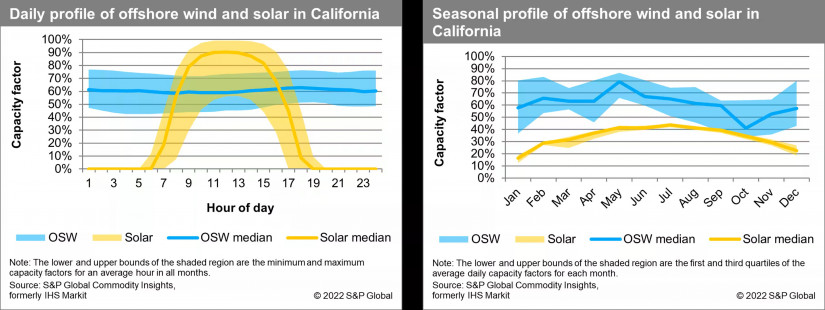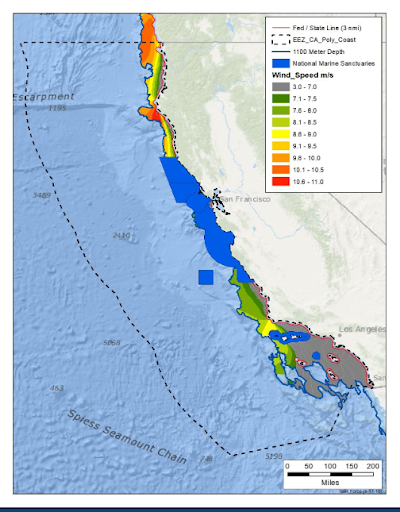Breadcrumb
- California Offshore Winds
- Renewable Energy Policy
Renewable Energy Policy
- What is California’s long term plan for renewables?
For electricity production, California intends to rapidly transition to renewable energy. California Senate Bill 100 requires all retail electricity sellers to procure a minimum quantity of electricity products from eligible renewable, zero-carbon generating energy resources so that the total kilowatt-hours of those products sold to their retail end-use customers is 50% of retail sales by December 31, 2026. Eligible renewable energy resources include solar, wind, geothermal, biomass, small hydro, renewable methane, ocean wave or thermal, or fuel cells using renewable fuels. By December 31, 2030, 60% of retail electricity sales must be renewable. By December 31, 2045, all retails sales of electricity to California end-use customers and state agency electricity needs will be powered with renewables. (1)
The Governor of California announced additional benchmarks. By 2035, the state will achieve 90% clean electricity and 95% by 2040.
In the transport sector, all cars sold in California by 2035 must be either hybrid or electric vehicles. These vehicles require public and private-charging infrastructure that will use electricty. (2)
- What is the plan for solar?
California plans to generate 69.6 GW from utility-scale solar operations and 28.2 GW from customer solar (rooftop panels). (1)
Part 6 of Title 24 of the Energy Code was updated in 2019 and went into effect in 2020, requires that all newly built residential homes, with some exceptions, install photovoltaic systems and meet other energy efficiency standards.
In April 2024, the Governor of California announced a projects to install solar panels over canals. The U.S. Bureau of Reclamation is also funding solar panel installations over Western canals. Initial solar-generation project sites will be along the Delta-Mendota Canal.
In May 2024, the California Public Utilities Commission (CPUC) expanded its community solar programs in particular to assist low-income customers living in disadvantaged communities to subscribe to solar projects and receive a guaranteed 20 percent electricity bill subsidy. The CPUC also enhanced its general “green tariff” program to allow commercial and residential users to subscribe to either singular solar projects or a pool of community solar projects. The decision will allow battery storage to be paired with solar projects to increase available renewables.
- What is the plan for wind?
In order to achieve electricity using zero-carbon energy, California created various energy scenarios in 2021 that would depend on a minimum of 10 GW of offshore wind available to the grid 2045. (3) By one estimate, California could generate 112 GW of offshore wind if there were not competing coastal uses of shipping, fishing, recreation, marine conservation, and Department of Defense priorities. (3) More recently, in 2023, California announced a planning goal of 25 GW of offshore wind with 2-5 GWs available by 2030. (4) This goal would require 1,600 floating offshore wind turbines. (5)
In June 2024, the California Energy Commission released its Offshore Wind Energy Strategy as required by Assembly Bill 525 that charged the agency with identifying offshore wind resources for California in federal waters and exploring impacts. The Strategic Plan is available in 3 volumes providing respectively an overview, a main report, and technical appendices. [6]
- Why not just invest in solar and on-shore wind?
To be able to generate the majority of California’s energy from renewables, California will need to be able to shift its sources of generation. When the sun is not shining or the wind is not blowing, California needs to be able to draw on a variety of energy resources. Offshore wind is available during the evening hours which are California’s peak electricity demand hours when other resources may not be available. Offshore wind is also available during winter months when solar production is lower.

- Why offshore wind in Humboldt Bay and the Central Coast?
Humboldt Bay has high wind speeds. Humboldt Bay will need additional transmission infrastructure to bring the offshore wind energy to the California grid. The Central Coast also has high wind speeds and has existing transmission infrastructure for 2.2 GW of energy load being used by Diablo Canyon Nuclear Power Plant. This transmission infrastructure may be able to be repurposed for offshore wind.

- References
- SB 100 California Renewables Portfolio Standard Program: Emissions of Greenhouse Gases https://leginfo.legislature.ca.gov/faces/billNavClient.xhtml?bill_id=201720180SB100
- Advanced Clean Cars II https://ww2.arb.ca.gov/our-work/programs/advanced-clean-cars-program/advanced-clean-cars-ii
- California Energy Commission, SB 100 Joint Agency Report: Charting a Path to a 100% Clean Energy Future (2021)
- Office of Governor, California Joins White House Partnership on Offshore Wind Energy https://www.gov.ca.gov/2023/02/22/california-joins-white-house-partnership-on-offshore-wind-energy/
- California Energy Commission, California Offshore Wind Fact Sheet, https://www.energy.ca.gov/sites/default/files/2023-11/California_Offshore_Wind_Fact_Sheet_ada.pdf
- California Energy Commission, https://www.energy.ca.gov/data-reports/reports/ab-525-reports-offshore-renewable-energy